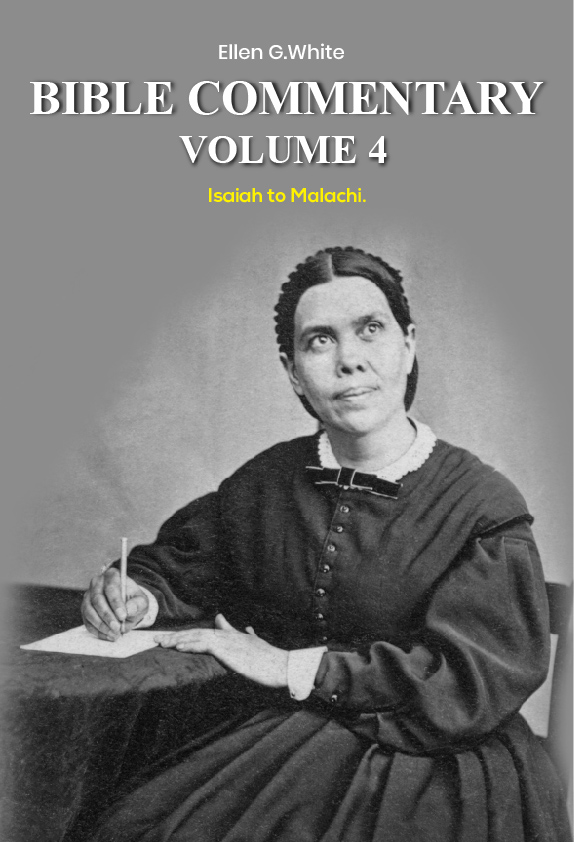Overview of EGW Comments SDA Bible Commentary, Vol. 4
The Seventh-day Adventist Bible Commentary, a multi-volume resource, integrates theological and historical commentary on Scripture, supplemented by insights from Ellen G. White, one of the most prominent figures in the Adventist tradition. Volume 4 of this series, spanning the books of Isaiah through Malachi, provides a rich tapestry of biblical interpretation and practical applications. Ellen White’s comments, interspersed throughout this volume, deepen the reader’s understanding by connecting timeless biblical principles with practical Christian living. Below, we explore the structure, content, and significance of this volume.
Structure and Scope
Volume 4 of the SDA Bible Commentary covers the last section of the Old Testament prophetic writings. These include the major prophetic book of Isaiah and the so-called “minor prophets” such as Hosea, Amos, Micah, and Malachi. This volume places special emphasis on the spiritual, moral, and eschatological messages of these texts. Ellen White’s contributions add theological depth and guidance, focusing on how these messages speak to individual believers and the corporate mission of the church.
Ellen G. White’s Role in the Commentary
Ellen G. White’s role in the Bible Commentary series is not to replace the biblical text or the scholarly exegesis but to enhance it. Her contributions draw on visions, personal reflections, and practical applications that clarify and reinforce biblical truths. In Volume 4, White’s commentary emphasizes the relationship between humanity and God, the responsibilities of God’s people in light of prophetic warnings, and the hope found in the promises of restoration and redemption.
Key Themes in Ellen G. White’s Comments
1. God’s Justice and Mercy
Ellen White often reflects on the balance of justice and mercy in the prophetic books. For instance, in Isaiah, she highlights God’s righteous judgment against sin but also His unyielding love and desire to save humanity. This duality is a recurring theme in her writings, pointing to Christ as the ultimate expression of justice and mercy.
In passages such as Isaiah 1:18 (“Come now, and let us reason together”), White emphasizes the invitation of God to sinners to repent and be reconciled. She underscores the idea that divine forgiveness is not just a pardon but a transformative experience that changes the heart and life of the believer.
2. The Role of the Prophets
White’s commentary underscores the crucial role of the prophets as God’s messengers. She portrays them as intermediaries who communicated divine truths to a wayward people, often at great personal cost. Isaiah’s prophetic call (Isaiah 6) and Jeremiah’s laments are particularly poignant examples. White calls on modern believers to be similarly faithful in their witness, even amidst opposition.
3. The Covenant Relationship
A recurring motif in the prophetic writings and White’s commentary is the covenant relationship between God and His people. She frequently addresses the conditional nature of the covenant: blessings come through obedience, while rebellion leads to discipline or judgment.
For instance, White’s insights into Hosea’s portrayal of God as a loving husband to unfaithful Israel illuminate the depth of God’s patience and commitment. She stresses the personal and corporate implications of covenant faithfulness, urging readers to live lives of integrity and devotion.
4. The Messiah and His Mission
The messianic prophecies of Isaiah and other prophets take center stage in White’s commentary. Passages such as Isaiah 53, which describe the suffering servant, are seen as direct references to Christ. White elaborates on how these texts foretell the mission of Jesus to redeem humanity through His sacrifice.
She links these Old Testament predictions with New Testament fulfillment, creating a seamless narrative of redemption. For instance, White emphasizes that Isaiah 9:6, which proclaims the coming of the “Wonderful Counselor, Mighty God,” not only anticipates Christ’s first advent but also assures believers of His ultimate reign.
5. Social Justice and the Prophetic Call to Reform
Ellen White draws out the ethical and social dimensions of the prophetic messages. In books like Amos and Micah, where the prophets denounce injustice and exploitation, White underscores the importance of living out the principles of God’s kingdom. She appeals to the Adventist community to advocate for justice, care for the poor, and resist the corruption of society.
Micah 6:8 (“He has shown you, O man, what is good”) becomes a central text in her commentary, exemplifying the call to “act justly, love mercy, and walk humbly with your God.” White applies these principles to both individual believers and the church as a collective body.
6. Eschatology and the Hope of Restoration
The prophetic books often oscillate between warnings of impending judgment and promises of restoration. Ellen White’s comments focus on the eschatological hope embedded in these writings. She connects Old Testament prophecies with Adventist eschatology, interpreting them as foretelling both the Babylonian exile and the ultimate restoration of God’s people at the end of time.
Malachi’s promise of the coming Elijah (Malachi 4:5-6) is seen as both a call for revival in White’s era and a prophecy of the final herald of Christ’s second coming.
Practical Applications
Personal Spirituality
White’s commentary often shifts from theological exposition to practical counsel, urging readers to apply the lessons of the prophets to their own spiritual lives. She warns against complacency, highlights the dangers of idolatry (both literal and modern forms), and calls for earnest prayer and repentance.
Corporate Mission
Ellen White also connects the prophetic messages to the mission of the Adventist Church. Just as ancient Israel was called to be a light to the nations, she sees the Adventist movement as tasked with proclaiming the everlasting gospel to the world. She frequently calls for vigilance, humility, and dedication to God’s work in the last days.
Educational and Social Reform
Another practical aspect of White’s commentary is her emphasis on education and reform. Reflecting on passages that address moral decay and societal corruption, she advocates for education that uplifts and transforms. She links spiritual renewal with social action, encouraging Adventists to make a tangible impact in their communities.
Significance of Volume 4 in the SDA Bible Commentary
Volume 4 of the SDA Bible Commentary is more than a scholarly work; it is a devotional and instructional resource. Ellen G. White’s contributions make it uniquely Adventist, blending biblical interpretation with spiritual guidance and practical application. This volume is particularly valuable for understanding:
- Prophetic Literature: It provides a detailed exploration of the often-complex writings of the prophets, making their messages accessible and relevant.
- Adventist Theology: White’s integration of prophetic themes with Adventist eschatology reinforces the denomination’s identity and mission.
- Christian Living: The practical applications encourage believers to live out their faith authentically, reflecting God’s character in their daily lives.
Conclusion
EGW Comments SDA Bible Commentary, Vol. 4 stands as a vital resource for both lay readers and scholars. Ellen White’s insights bridge the ancient context of the prophets with the contemporary challenges of modern faith. Her emphasis on justice, mercy, and covenant faithfulness resonates deeply, urging believers to embrace their spiritual heritage while looking forward to the ultimate fulfillment of God’s promises. This volume invites readers to not only study the prophetic books but to live out their transformative messages.





